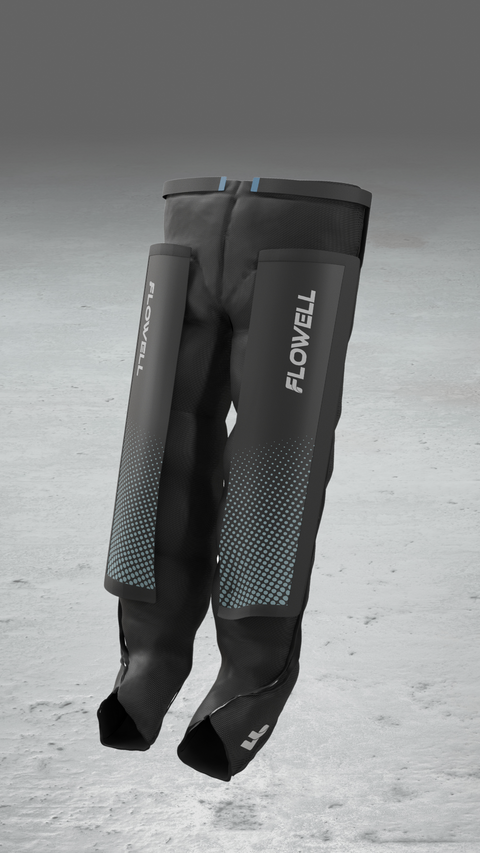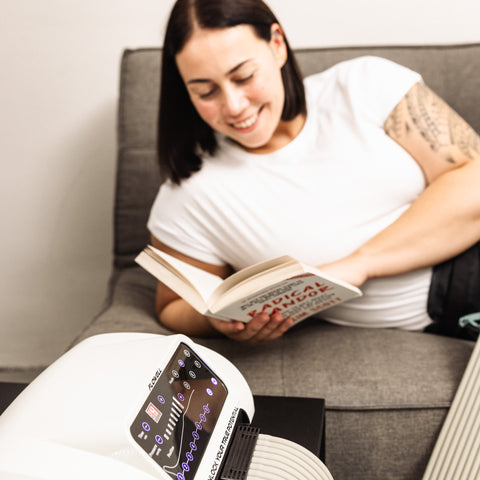This is the story of Amanda, but it could be your story, too.
In the golden hour of a Tuesday evening, Amanda finally unlocks her apartment door. The consulting presentation that kept her seated for nine straight hours is successfully delivered. Her mind is still racing with client feedback and follow-up tasks, but her legs—they tell a different story altogether.
"By 6 PM, my mind is still in fifth gear, but my legs feel like they're filled with wet sand," she admits, sinking into her couch. This is the untold reality of the modern professional: brilliant minds trapped in bodies paying the price of sedentary success.
Amanda's experience isn't unique. While we celebrate career milestones and professional achievements, collecting likes and comments, many quietly struggle with the physical toll of desk-bound excellence.
The Silent Symptoms We've Normalized
Medical research confirms what many professionals experience daily—prolonged sitting dramatically reduces circulation in the lower extremities. According to the Journal of Vascular Health (2024), a staggering 78% of office workers report leg discomfort by day's end, with over half experiencing noticeable swelling.
What we dismiss as normal "end-of-day tired legs" actually signals the body's lymphatic system struggling to function properly. This system—responsible for removing excess fluid and waste—depends on physical movement to function efficiently.
"I ignored the signs for months," Amanda reflects. "The heaviness, the slight swelling around my ankles, how my jewelry left deeper marks in the evening. I just accepted it as part of having a demanding job."
Common symptoms that shouldn't be normalized include:
- Evening leg heaviness that feels disproportionate to your activity level
- Visible swelling around ankles that improves after elevating legs
- Indentations from socks or jewelry that deepen throughout the day
- Tight skin sensation in calves or feet by evening
- Restless legs when trying to relax after work
The lymphatic system lacks a central pump like the heart. It relies heavily on muscle contractions to move fluid. When we remain seated for hours, this natural pumping mechanism essentially stops working.
From Traditional Solutions to Modern Innovations
For decades, medical-grade compression stockings were the primary recommendation for addressing leg swelling and circulation issues. While effective, they carried significant drawbacks—they were difficult to put on, uncomfortable in warm weather, visibly medical, and frankly, not designed for the modern professional lifestyle.
"When my doctor suggested compression socks, I bought them but rarely wore them," Amanda confesses. "They were hot, took forever to put on, and honestly made me feel like I had a medical condition rather than just a job that required sitting."
This experience reflects why only an estimated 30% of people recommended compression therapy maintain consistent use, according to Compliance in Vascular Medicine (2023).
The gap between medical necessity and lifestyle reality is precisely why innovative solutions like Flowell compression pants have transformed the approach to leg wellness.
The Discovery: Compression That Fits Modern Life
Amanda's turning point came unexpectedly through a colleague who mentioned her own post-work ritual.
"She showed me these sleek, almost stylish compression pants by Flowell—nothing like the beige stockings gathering dust in my drawer. The difference was immediate: they were easy to slip in, comfortable and felt like I had a physical therapist waiting for me at home."
Unlike traditional compression garments that apply static pressure, Flowell's dynamic compression technology mimics the natural pumping action of walking:
- Sequential compression moves from ankle to thigh, precisely mimicking natural lymphatic flow
- Programmable intensity adapts to individual needs and sensitivity
- Breathable, lightweight material designed for comfort during extended sessions
"The first time I used them after a particularly grueling day of back-to-back meetings, I actually said 'oh' out loud," Amanda laughs. "There's something profoundly relieving about feeling fluid movement resume in legs that have been stagnant all day."
CHECK OUT FLOWELL & HOW IT CAN HELP
When and How: Integrating Compression into Real Life
For busy professionals, adding another health routine might seem daunting. However, Amanda's experience reflects what many Flowell users discover—compression therapy easily integrates into existing downtime.
Optimal times for compression therapy include:
- During evening relaxation while reading, watching shows, or catching up on non-urgent emails
- After long flights or travel when leg swelling is particularly pronounced
- During recovery from intense standing periods for retail, healthcare, or service professionals
Most users report significant benefits from 30-45 minute sessions, though individual needs vary based on severity of symptoms and daily activity levels.
"I've turned it into my transition ritual," explains Amanda. "I come home, change into comfortable clothes, slip on my Flowell pants, and use that 30 minutes to mentally decompress while my legs physically recover. It's become my boundary between work and personal time."
Beyond Physical Relief: The Full-Circle Wellness Connection
What began as a solution for leg discomfort has evolved into something more comprehensive for many users. The regular practice of taking time for compression therapy creates a structured pause in otherwise chaotic schedules.
Research published suggests that regular physical recovery rituals like compression therapy provide psychological benefits beyond their direct physiological effects. The act of deliberately pausing for recovery signals to both body and mind that restoration is a priority.
"There's something powerful about taking deliberate action for your well-being," Amanda notes. "It shifts your perspective from seeing your body as something that should just automatically keep up with your ambitions to recognizing it needs intentional care."
Benefits extend beyond the immediacy of reduced swelling:
- Improved sleep quality as legs feel lighter and more comfortable at bedtime
- Reduced nighttime cramping often associated with daily fluid retention
- Decreased next-day fatigue as the body expends less energy combatting poor circulation
- Enhanced overall mobility with less stiffness and heaviness
The Flowell Difference: Designed for Real Lives
What distinguishes Flowell from both traditional medical compression and athletic recovery systems is its design philosophy centered on lighter legs for everyone rather than a specific target group like athletes only.
| Feature | Traditional Compression Stockings | Athletic Recovery Systems | Flowell Compression Pants |
|---|---|---|---|
| Application | Difficult, time-consuming | Focuses on legs only | Full coverage up to your belly |
| Appearance | Medical, visible under clothing | Athletic, bulky | Design and lifestyle-oriented, it´s a product you are proud to have |
| Compression Type | Static, constant pressure | Intense, designed for athletes | Dynamic, adaptive to sedentary needs, different sequences |
| Use Case | Primarily medical | Performance-focused | Flexible use to adjust to different user groups |
| User Experience | Often uncomfortable, hot | Powerful but overwhelming | Comfortable, adjustable |
"The design thoughtfulness is what converted me," says Amanda. "The controller is intuitive, the material doesn't make me overheat, and I don't feel like I'm wearing medical equipment. I'm just taking care of myself in a way that acknowledges my actual lifestyle."
Taking the First Step Toward Better Leg Health
If Amanda's experience resonates with your own end-of-day leg heaviness, consider asking yourself:
- Do your legs feel disproportionately tired compared to the rest of your body?
- Have you noticed subtle swelling that improves with elevation?
- Do you find yourself avoiding evening activities due to leg discomfort?
- Have traditional compression options proven unsustainable for your lifestyle?
For most busy professionals, the ideal approach starts with:
- Recognize the signals your body is sending through symptoms
- Integrate movement breaks whenever possible during work hours
- Establish a recovery ritual that works with your existing routine
- Consider modern compression designed for your actual lifestyle
"Your legs carry you through life's demands—they deserve more than being an afterthought," reflects Amanda. "The physical relief is immediate, but the real value is in acknowledging that taking care of your body isn't optional or something to postpone until 'someday when I'm less busy.'"
For professionals navigating demanding careers while trying to maintain physical wellbeing, solutions like Flowell represent more than just leg care—they offer a practical compromise between the realities of modern work and our body's fundamental needs.
Ready to transform your evening routine? Explore the Flowell collection designed specifically for busy professionals and take the first step toward comprehensive leg wellness.





